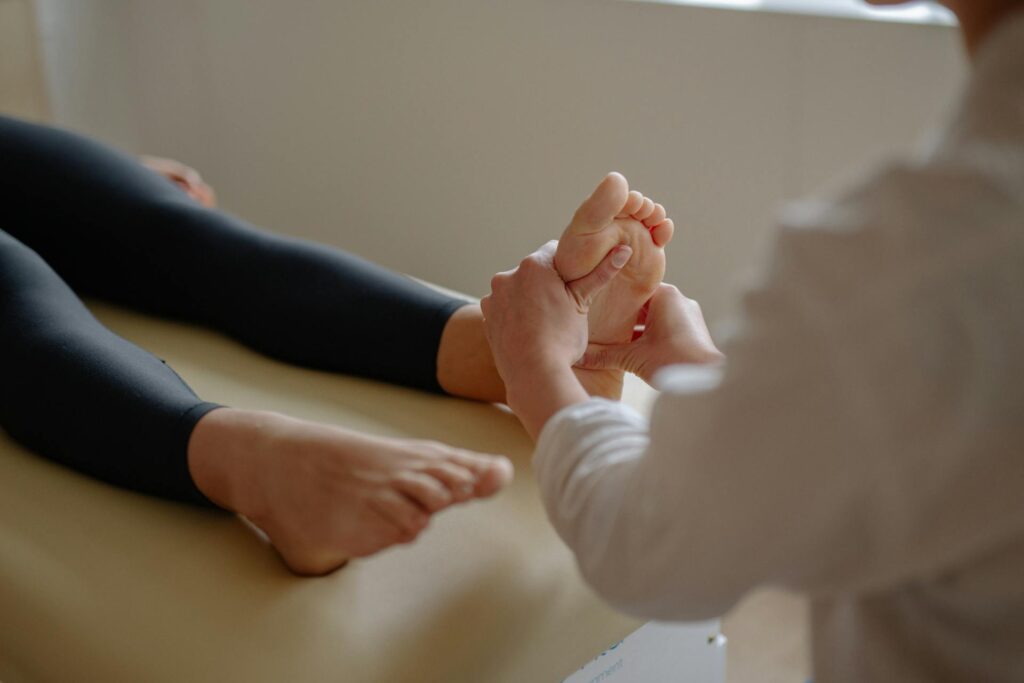Why Your Feet Hurt: Types of Foot Pain and Physiotherapy Options

Why Your Feet Hurt: Types of Foot Pain and Physiotherapy Options in Newmarket
That first painful step out of bed in the morning. The burning ache that builds during your work shift. The sharp twinges that make you avoid your favorite activities. Foot pain affects nearly 75% of adults at some point, yet many suffer needlessly because they don’t understand what’s causing it or how to properly treat it. At PhysioChiroWellness, our physiotherapy in Newmarket clinic specializes in diagnosing and treating the root causes of foot pain – not just masking symptoms.
Understanding Your Foot’s Complex Anatomy
Before examining specific conditions, it’s important to appreciate how complex your feet really are. Each foot contains:
- 26 bones (about 25% of all bones in your body)
- 33 joints that allow flexible movement
- More than 100 muscles, tendons and ligaments
- Thousands of nerve endings that provide balance feedback
This intricate structure means there are many potential sources of pain when something goes out of alignment or becomes inflamed. The location and nature of your pain often provides important clues about what’s really going on.
Most Common Types of Foot Pain
1. Plantar Fasciitis: The Dreaded Heel Pain
What it feels like:
- Sharp, stabbing pain at the bottom of your heel
- Typically worst with the first steps in morning
- May improve slightly with movement but returns after rest
What’s really happening:
The plantar fascia – a thick band of tissue running along the bottom of your foot – becomes inflamed from overuse or improper mechanics. Small tears develop where it attaches to your heel bone.
Why typical treatments fail:
Most people try stretching and ice, which helps temporarily but doesn’t address the underlying biomechanical issues causing the strain.
How physiotherapy helps:
- Graston technique to break up fascial adhesions
- Custom orthotics to support proper arch alignment
- Eccentric calf stretches that actually rebuild tissue strength
- Gait analysis to correct walking patterns
2. Posterior Tibial Tendon Dysfunction: The Collapsing Arch
What it feels like:
- Dull ache along the inner arch and ankle
- Fatigue when standing or walking for long periods
- Possible swelling along the tendon line
What’s really happening:
The tendon that supports your arch becomes weakened, allowing your foot to flatten excessively. This puts strain on surrounding structures.
Risk factors:
- Overpronation (feet rolling inward too much)
- Obesity or sudden weight gain
- Hypertension or diabetes affecting circulation
Physiotherapy solutions:
- Balance training to strengthen intrinsic foot muscles
- Kinesiology taping for temporary arch support
- Progressive resistance exercises for the tibialis posterior
3. Metatarsalgia: Forefoot Fire
What it feels like:
- Burning or bruised sensation under the ball of foot
- Sharp pains when walking barefoot or in thin shoes
- Possible numbness in toes
Common causes:
- Tight calf muscles increasing forefoot pressure
- Worn-out shoes losing their cushioning
- Stress fractures from overuse
- Morton’s neuroma (nerve inflammation)
Professional treatment options:
- Joint mobilizations to improve toe flexibility
- Offloading pads to redistribute pressure
- Laser therapy to reduce nerve inflammation
- Footwear modification advice
4. Bunions & Hammertoes: The Deformity Dilemma
What you notice:
- Bony bump at base of big toe (bunion)
- Bent, stiff toes that won’t straighten (hammertoes)
- Painful corns/calluses from rubbing
Why they develop:
- Genetic foot structure tendencies
- Years of narrow-toe shoe wear
- Muscle imbalances pulling toes out of alignment
- Arthritis changes in joints
Conservative treatment approaches:
- Toe spacers and correctors
- Joint mobilizations to maintain mobility
- Padding strategies to reduce pressure
- Strengthening exercises for proper alignment
How Physiotherapy in Newmarket Provides Lasting Relief
Unlike temporary solutions like pain medication or generic orthotics, our approach at PhysioChiroWellness focuses on:
1. Comprehensive Assessment
We examine:
- Your standing and walking mechanics
- Footwear wear patterns
- Joint mobility throughout lower body
- Muscle strength imbalances
2. Targeted Treatment Plans
Your customized plan may include:
- Manual therapy for stiff joints
- Therapeutic ultrasound for deep inflammation
- Dry needling for tight muscles
- Laser therapy to accelerate healing
- Custom orthotics when truly needed
3. Prevention Strategies
We provide:
- Footwear recommendations specific to your foot type
- Workplace ergonomics for standing jobs
- Sport-specific conditioning programs
- Home exercise programs with video demos
“After years of heel pain, physiotherapy fixed in 8 weeks what orthotics alone couldn’t in 5 years.” — James, Newmarket teacher
When to Seek Professional Help
Don’t wait until the pain becomes debilitating. Schedule an assessment if you experience:
- Pain lasting more than 2 weeks
- Swelling that doesn’t improve with rest
- Difficulty bearing full weight
- Numbness/tingling in feet
- Visible changes in foot shape
Take the First Step Toward Pain-Free Feet
At PhysioChiroWellness, our physiotherapy in Newmarket offers:
- Same-day appointments for acute pain
- Extended 45-minute treatment sessions
- Collaborative care with chiropractors
- Direct billing to most insurance plans
Book your comprehensive foot assessment today and start walking comfortably again.
